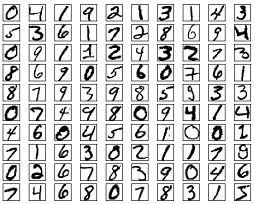Logistic Regression Example
A logistic regression learning algorithm example using TensorFlow library.
- Author: Aymeric Damien
- Project: https://github.com/aymericdamien/TensorFlow-Examples/
MNIST Dataset Overview
This example is using MNIST handwritten digits. The dataset contains 60,000 examples for training and 10,000 examples for testing. The digits have been size-normalized and centered in a fixed-size image (28x28 pixels) with values from 0 to 1. For simplicity, each image has been flattened and converted to a 1-D numpy array of 784 features (28*28).

More info: http://yann.lecun.com/exdb/mnist/
import tensorflow as tf
# Import MINST data
from tensorflow.examples.tutorials.mnist import input_data
mnist = input_data.read_data_sets("/tmp/data/", one_hot=True)
Extracting MNIST_data/train-images-idx3-ubyte.gz
Extracting MNIST_data/train-labels-idx1-ubyte.gz
Extracting MNIST_data/t10k-images-idx3-ubyte.gz
Extracting MNIST_data/t10k-labels-idx1-ubyte.gz
# Parameters
learning_rate = 0.01
training_epochs = 25
batch_size = 100
display_step = 1
# tf Graph Input
x = tf.placeholder(tf.float32, [None, 784]) # mnist data image of shape 28*28=784
y = tf.placeholder(tf.float32, [None, 10]) # 0-9 digits recognition => 10 classes
# Set model weights
W = tf.Variable(tf.zeros([784, 10]))
b = tf.Variable(tf.zeros([10]))
# Construct model
pred = tf.nn.softmax(tf.matmul(x, W) + b) # Softmax
# Minimize error using cross entropy
cost = tf.reduce_mean(-tf.reduce_sum(y*tf.log(pred), reduction_indices=1))
# Gradient Descent
optimizer = tf.train.GradientDescentOptimizer(learning_rate).minimize(cost)
# Initialize the variables (i.e. assign their default value)
init = tf.global_variables_initializer()
# Start training
with tf.Session() as sess:
sess.run(init)
# Training cycle
for epoch in range(training_epochs):
avg_cost = 0.
total_batch = int(mnist.train.num_examples/batch_size)
# Loop over all batches
for i in range(total_batch):
batch_xs, batch_ys = mnist.train.next_batch(batch_size)
# Fit training using batch data
_, c = sess.run([optimizer, cost], feed_dict={x: batch_xs,
y: batch_ys})
# Compute average loss
avg_cost += c / total_batch
# Display logs per epoch step
if (epoch+1) % display_step == 0:
print "Epoch:", '%04d' % (epoch+1), "cost=", "{:.9f}".format(avg_cost)
print "Optimization Finished!"
# Test model
correct_prediction = tf.equal(tf.argmax(pred, 1), tf.argmax(y, 1))
# Calculate accuracy for 3000 examples
accuracy = tf.reduce_mean(tf.cast(correct_prediction, tf.float32))
print "Accuracy:", accuracy.eval({x: mnist.test.images[:3000], y: mnist.test.labels[:3000]})
Epoch: 0001 cost= 1.182138959
Epoch: 0002 cost= 0.664778162
Epoch: 0003 cost= 0.552686284
Epoch: 0004 cost= 0.498628905
Epoch: 0005 cost= 0.465469866
Epoch: 0006 cost= 0.442537872
Epoch: 0007 cost= 0.425462044
Epoch: 0008 cost= 0.412185303
Epoch: 0009 cost= 0.401311587
Epoch: 0010 cost= 0.392326203
Epoch: 0011 cost= 0.384736038
Epoch: 0012 cost= 0.378137191
Epoch: 0013 cost= 0.372363752
Epoch: 0014 cost= 0.367308579
Epoch: 0015 cost= 0.362704660
Epoch: 0016 cost= 0.358588599
Epoch: 0017 cost= 0.354823110